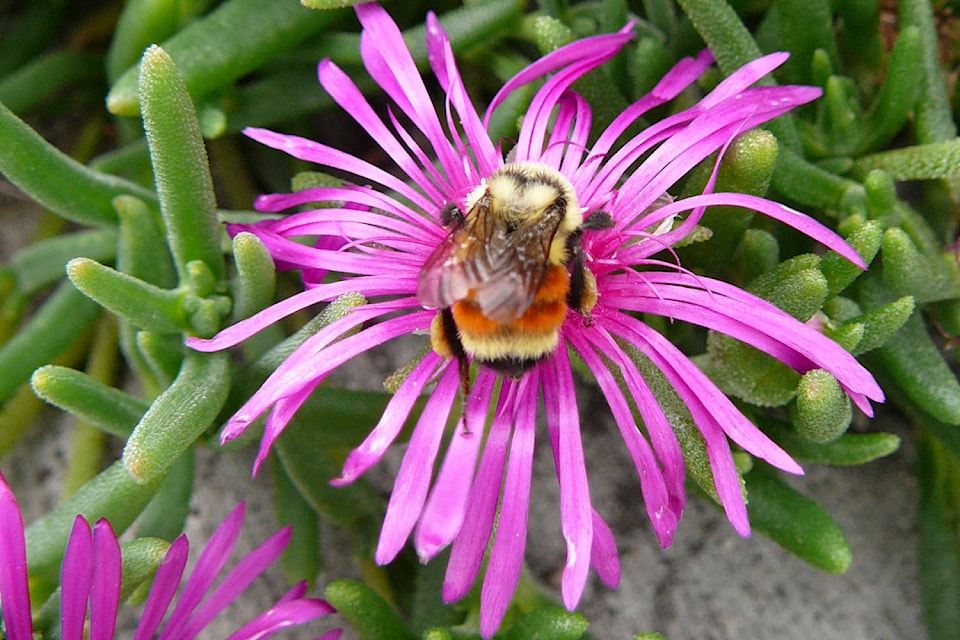I invite you to join me on Thursday, Aug. 2 at 7 p.m. for a free presentation at the unH2O Xeriscape Demonstration Garden, 4075 Gordon Drive in front of the H2O Aquatic Centre.
I’ll be talking about the plants that are in bloom, characteristics of drought tolerant plants, and answering questions about water-wise gardening.
The garden is comprised of six theme gardens to help gardeners select water-wise groupings of plants that appeal to them.
The Native Garden contains extremely drought tolerant plants, watered in the first year only.
The Mediterranean Garden and Rock/gravel Garden thrive with a small amount of supplemental water during prolonged dry spells.
The Butterfly Garden and the Ornamental Grass Garden are irrigated weekly during hot, dry weather.
Our new tapestry lawn, planted early May, is filling in well. It consists of native yarrow and a stepping stone path infilled with elfin thyme.
It’s being hand watered this year to get it established but should thrive without supplemental water after this first season.
Here are some characteristics of drought tolerant plants:
1) Silver foliage reflects the sun’s heat away from the plant.
Examples in the Mediterranean Garden: Nepeta ‘Walker’s Low, lavender and santolina.
In the Rock Garden: alpine marguerite, pussytoes, silver mound, and blue hair grass.
In the Ornamental Grass Garden: blue oat grass, Sedum ‘Arctic Fire’
2) Leathery leaves decrease evaporation from the plant.
Examples in the Mediterranean Garden: Yucca ‘Golden Sword’ and German statice.
3) Succulent leaves retain moisture.
Examples in the Mediterranean Garden: Delosperma cooperi and sempervivums (hen and chicks), Sedum ‘Postman’s Pride, Sedum ‘Matrona’.
In the Rock Garden: sedums.
4) Small surface area of needle-like foliage decreases evaporation.
Examples in the Mediterranean Garden: lavender,
In the Rock Garden: Penstemon pinifolius.
5) Plants such as spring bulbs and many of our native flowers bloom in spring when the ground is still moist from snow melt. Then they go dormant to avoid summer heat and dry conditions.
I hope you will come on July 25, or at another time, to see the colourful xeriscape garden.
6) Tap roots go deep into the soil for moisture.
Examples are yucca and Missouri evening primrose in the Mediterranean Garden.
We will have copies of my favourite xeriscape reference ‘Creating the Prairie Xeriscape’ by Sara Williams for sale as well as photo cards of plants in the garden and 2018 OXA memberships.
All are fund raisers for the Okanagan Xeriscape Association (OXA).
Brochures with the plant list are available from a box beside the main sign in the garden.
This fall, xeriscape expert Eva Antonijevic will be teaching the popular OXA workshop “Introduction to the Seven Principles of Xeriscape” on
Saturday, Sept. 29, 10 a.m. to 2 p.m. in Kelowna (location TBA) or Saturday, Oct. 13, 10 a.m to 2 p.m. at Summerland Ornamental Gardens.
Details and registration information are on the ‘classes’ page of the OXA website.
Gwen Steele is executive-director of the non-profit Okanagan Xeriscape Association. Learn more about Gardening with Nature and plants for the Okanagan on the website at www.okanaganxeriscape.org
